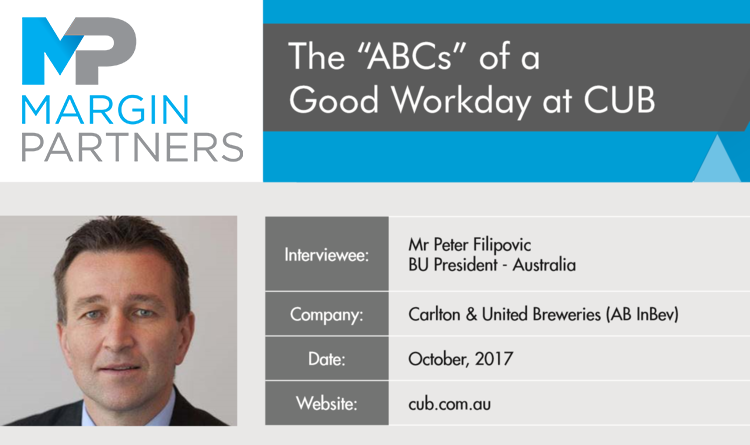1. Describe a good Workday for yourself?
There are four key ingredients that make up my good day. The first comes through communicating and interacting with our people, in a manner that cascades the strategy and vision of our company into their daily life.
The second is having rich customer conversations that allow an easy exchange of both positive and negative feedback. I consider this vital information that must be immediately fed back through the organisation, so that we can adapt and respond quickly.
Time out in the trade viewing firsthand how consumers are responding to our brands, is my third requirement for building a productive day. Watching how Consumers select, purchase and enjoy gives me an instant feel for what’s working and what’s not.
The final action is having a ‘win’! A win can range from securing a new tap, venue or promotional space to seeing a brand spike dramatically or a person in the organisation succeed.
2. On average, how many good Workdays do you have a month?
I have more good workdays than bad. Even after some 20 years at CUB, I continue to learn something new most days. I make a point of travelling around Australia and actively engage with our customers and people. Then I believe I am seeing, firsthand, how the execution of our strategy is working.
3. Describe a good Workday for your organisation’s P&L?
The P&L has 12 opportunities a year to have a good workday & obviously the number at year’s end is extra important. You look at it each month and compare the vital metrics of Units sold, Revenue and Profit against Budget and Prior Year. But there is more. Our people, especially the Sales team, need to be responding to daily and weekly measures. We have lead performance indicators such as Call Rates, Display Targets, Promotional Frequency etc that ultimately point to what the month end result is likely to be. It’s like reviewing the “player data”, that leading AFL teams such as Hawthorn use to ascertain the foundations required for success.
4. Do the two good Workdays align?
A good workday for the P&L and for me, are not just aligned, they are completely co-dependant. Delivery of our Financial Targets is always the major priority, but that won’t happen unless the four key items I touched on earlier take place.
It’s an ongoing cycle of communication. We need to share the Vision, put the resulting Plans into action and respond to real time market feedback.
5. Where is Margin Erosion most likely to occur in your sector?
I point very clearly to my ‘ABC’ mantra of “Arrogance, Bureaucracy and Complacency”.
Our customers won’t tolerate Arrogance. They have choices available to them and we want them to choose us. It’s essential that we engage them with humility and respect.
Bureaucracy is my major focus at present. It’s where margin erosion can occur the most. Essentially, we are a simple business that makes and sells great Beer. Internal processes shouldn’t get in the way of what we do. But they can and it’s costly. As a large company we need to continuously determine if our customers are finding it easier or harder to deal with us.
Complacency can arise when you have a market leading portfolio of brands. It can be a case of people just expecting that results will automatically follow.
Ultimately, I’m encouraging people to be the best they can be. I want distance between us and our competition.
6. Key Takeout:
Despite being the largest brewer in Australia, Peter Filipovic emphasises not taking any aspect of this for granted. Customer sensitivity and service require constant attention from all levels of the business. A quality and action that he is proud to exemplify and lead with by example
Brewing in Australia continues to evolve and is no longer the bastion of a monopoly or duopoly of major Beer producers. Within this, CUB continue to transform their professional culture in a manner that places primacy on remaining attentive, responsive and genuine. The company is a crisp and refreshing example of how getting the “ABCs” (as Peter would have it) of finding and eliminating margin erosion right can drive sustainable, long-term growth in any business.



